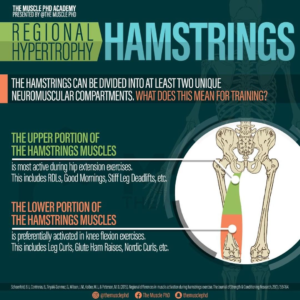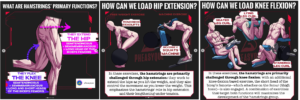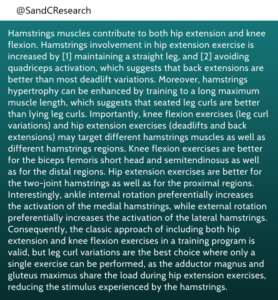HAMSTRINGS – RESEARCH
Click on Image to Enlarge
TRAINING
AGING
Age-related muscle atrophy in the lower extremities and daily physical activity in elderly women – 2011 – Ikezoe
Procedure
– relationship between age-related declines in muscle thickness of lower extremities daily physical activity in elderly women
– 20 young women and 17 elderly women residing in a nursing home
– Daily physical activity was evaluated using life-space assessment (LSA) which assessed degree of independence
Results
– Biceps Femoris and Psoas were the most atrophied
– Only the Gluteus Medius was significantly associated with the LSA score
HAMSTRINGS REVIEW
– Including Moment Arm data
Hamstrings – Beardsley
#1. Individual hamstrings muscles are very different from one another
– Unlike the quadriceps (which display very similar muscle architecture), the individual hamstrings muscles display very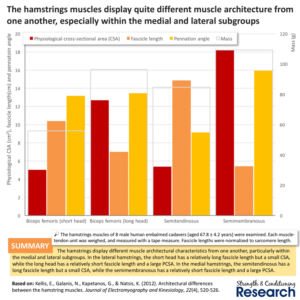 different architecture from one another.
different architecture from one another.
– It is possible that this variety allows the muscle group to produce force more consistently across a very wide range of muscle shortening velocities.
#2. Hamstrings muscles display very similar internal moment arm lengths
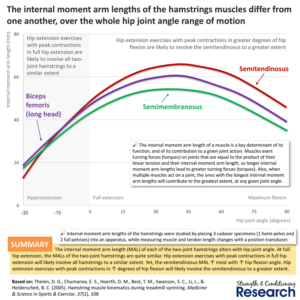
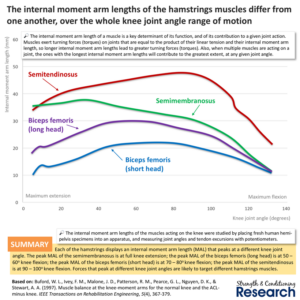 – Even though the individual hamstrings muscles display very different muscle architecture from one another they display fairly similar internal moment arm lengths for hip extension.
– Even though the individual hamstrings muscles display very different muscle architecture from one another they display fairly similar internal moment arm lengths for hip extension.
– the biceps femoris long head (a lateral hamstring) displays the best leverage in full hip extension
– the semitendinosus (a medial hamstring) displays the best leverage when the hip is flexed.
– This may mean training hip extension with peak contraction in full hip extension (such as a horizontal back extension) will preferentially train the biceps femoris long head, while training hip extension with peak contraction in full hip flexion (such as an RDL) will preferentially train the semitendinosus
#3A. Hip extension and knee flexion can target different hamstrings
– When comparing hip extension and knee flexion exercises, a couple of studies have shown that knee flexion exercises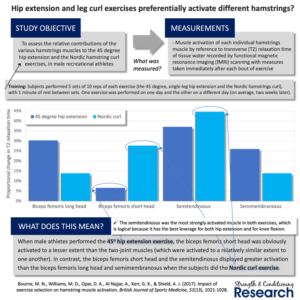 (leg curl variations) tend to target the biceps femoris short head and the semitendinosus.
(leg curl variations) tend to target the biceps femoris short head and the semitendinosus.
– In contrast, hip extension exercises (deadlifts and back extensions) tend to target the three two-joint hamstrings.
– This suggests that a combination of knee flexion and hip extension exercises may help maximize hamstrings hypertrophy.
#3B. Hip extension and knee flexion can target different hamstrings regions
– When comparing hip extension and knee flexion exercises, some research has shown that hip extension exercises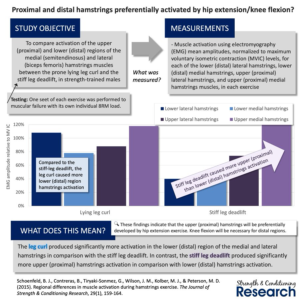 tend to target the proximal region of the medial and lateral hamstrings.
tend to target the proximal region of the medial and lateral hamstrings.
– In contrast, knee flexion exercises tend to produce a more consistent response across the proximal and distal regions.
– This also suggests that both hip extension and knee flexion exercises may be helpful for maximizing hypertrophy of the hamstrings
#4. Generally, knee flexion is the most effective way for training the hamstrings
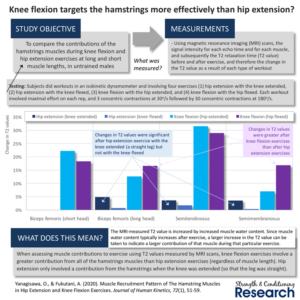
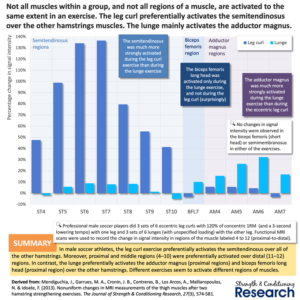 – Leg curl variations are a much more effective way of targeting the hamstrings, since they by far the most important muscle group that contributes to knee flexion.
– Leg curl variations are a much more effective way of targeting the hamstrings, since they by far the most important muscle group that contributes to knee flexion.
– This is probably because hip extension exercises also involve the gluteus max (particularly when peak forces are produced in full hip extension, such as in the glute bridge exercise) and the adductor magnus particularly when peak forces are produced in hip flexion, such as in lunges or squats
#5. Hamstrings muscles can be preferentially activated by altering ankle rotation angle
– One very small observation that could be valuable for advanced bodybuilders is that ankle position affects the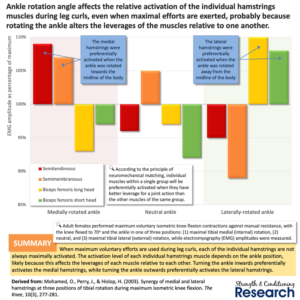 relative activation levels of the lateral and medial hamstrings groups.
relative activation levels of the lateral and medial hamstrings groups.
– By turning the ankle in different directions, a bodybuilder can preferentially activate different hamstrings muscles, targeting hypertrophy to specific regions.
#6. Hamstrings muscles respond to being trained at long maximal muscle lengths
– Although it is commonly assumed that strength training with a large range of motion (or more accurately to a long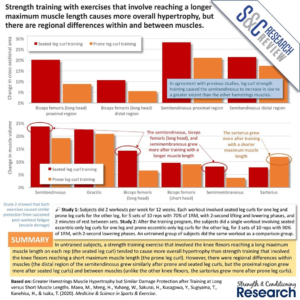 maximum muscle length) is superior for hypertrophy for all muscle groups, this is not the case.
maximum muscle length) is superior for hypertrophy for all muscle groups, this is not the case.
– Some muscles (such as the triceps brachii) respond similarly to being trained to both long and short maximum muscle lengths.
– This is because it is the sarcomere length that determines the additional passive tension that is experienced during a strength training exercise and not the muscle length itself.
– Nevertheless, the hamstrings do seem to experience additional passive tension when trained at longer maximum muscle lengths
#7. Hamstrings muscle activation is increased when the leg is straight
– Hip extension exercise can be used to train the hamstrings.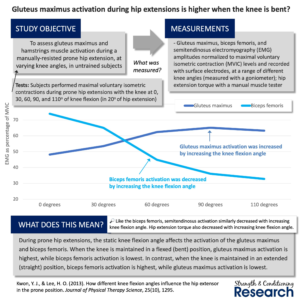
– Nevertheless, the position of the knee joint during hip extension movements affects the relative involvement of the hamstrings and gluteus maximus muscles.
– When knee is bent (flexed) as in squat and most deadlift variations, gluteus max activation is increased relative to hamstrings
– In contrast, when the knee is straight as in back extensions and some deadlift variations, hamstrings activation is increased relative to the gluteus maximus.
#8. Hamstrings muscle activation is decreased when the quadriceps are active
– Hip extension exercise can be used to train the hamstrings.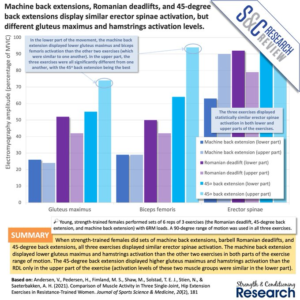
– Some hip extension exercises (like back extensions) do not involve any quadriceps activation.
– In contrast, other hip extension exercises (like squats, deadlifts, and hip thrusts) do involve substantial quadriceps activation.
– Importantly, the activation of the quadriceps reduces the level of hamstrings activation (probably because adductor magnus activation is simultaneously increased).
– In addition to the use of an entirely straight leg, this phenomenon may also help explain why the back extension exercise seems to be superior to deadlift variations for activating the hamstrings.
